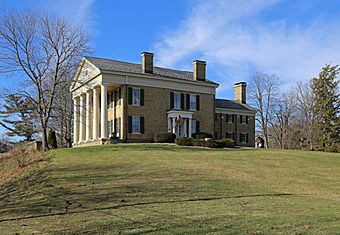Stonehall (Marshall, Michigan) facts for kids
Quick facts for kids |
|
|
Stonehall
|
|
|
U.S. National Historic Landmark District
Contributing Property |
|
 |
|
| Location | 303 N. Kalamazoo St., Marshall, Michigan |
|---|---|
| Area | 1 acre (0.40 ha) |
| Built | 1837 |
| Architectural style | Greek Revival |
| Part of | Marshall Michigan Historic Landmark District (ID91002053) |
| NRHP reference No. | 72000600 |
| Added to NRHP | June 28, 1972 |
Stonehall, also known as the Andrew L. Hayes House, is a beautiful old home in Marshall, Michigan. It's located at 303 North Kalamazoo Street. This house is so special that it was added to the National Register of Historic Places in 1972. Many people consider it one of the best examples of Greek Revival architecture in Michigan. This style of building looks a lot like ancient Greek temples!
The Story of Stonehall
The story of Stonehall begins with Dr. Andrew L. Hayes. He arrived in Marshall, Michigan, in 1831 from New Hampshire. He was the very first doctor in this new community! Dr. Hayes first bought land and built a simple shanty, then a log cabin.
As he became more successful, Dr. Hayes bought four more pieces of land in 1836. He wanted to build a grand new house there. Construction on Stonehall started in 1837, and his family moved into the first finished part that same year. The rest of the house was completed in 1838.
The Hayes family lived in Stonehall for over 30 years. During this time, their home became a very important place for social gatherings in Marshall. Later, in 1877, a large glass room called a conservatory was added to the house.
Over the years, Stonehall has had several different owners. Many of them were important people in the Marshall community. Around the early 1900s, the house became known as "Stonehall." For a period between 1910 and 1924, it was even used as a home and a day school for girls.
What Does Stonehall Look Like?
Stonehall is a large, two-story house made of sandstone. It also has a basement and a special ballroom on the third floor!
The front of the house has a very noticeable porch area called a portico. This portico has five tall, slender columns that look like those found on ancient Greek buildings. Above the columns, there's a round window. The house also has white painted wood trim that makes it stand out.
Four tall windows face the front portico. The main door to the house is on one side. It's protected by a smaller porch that also has two columns. All these details make Stonehall a wonderful example of Greek Revival architecture.

